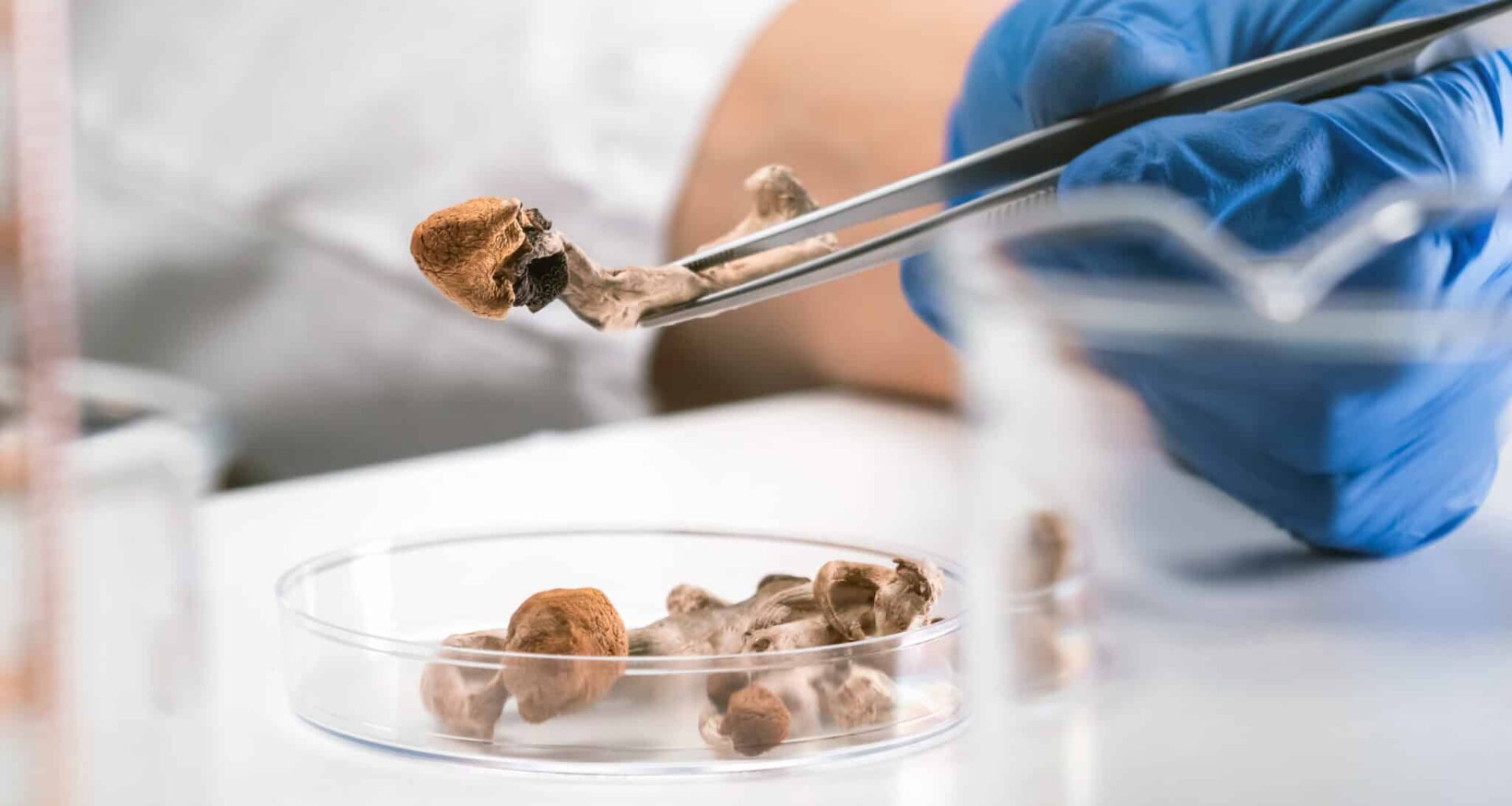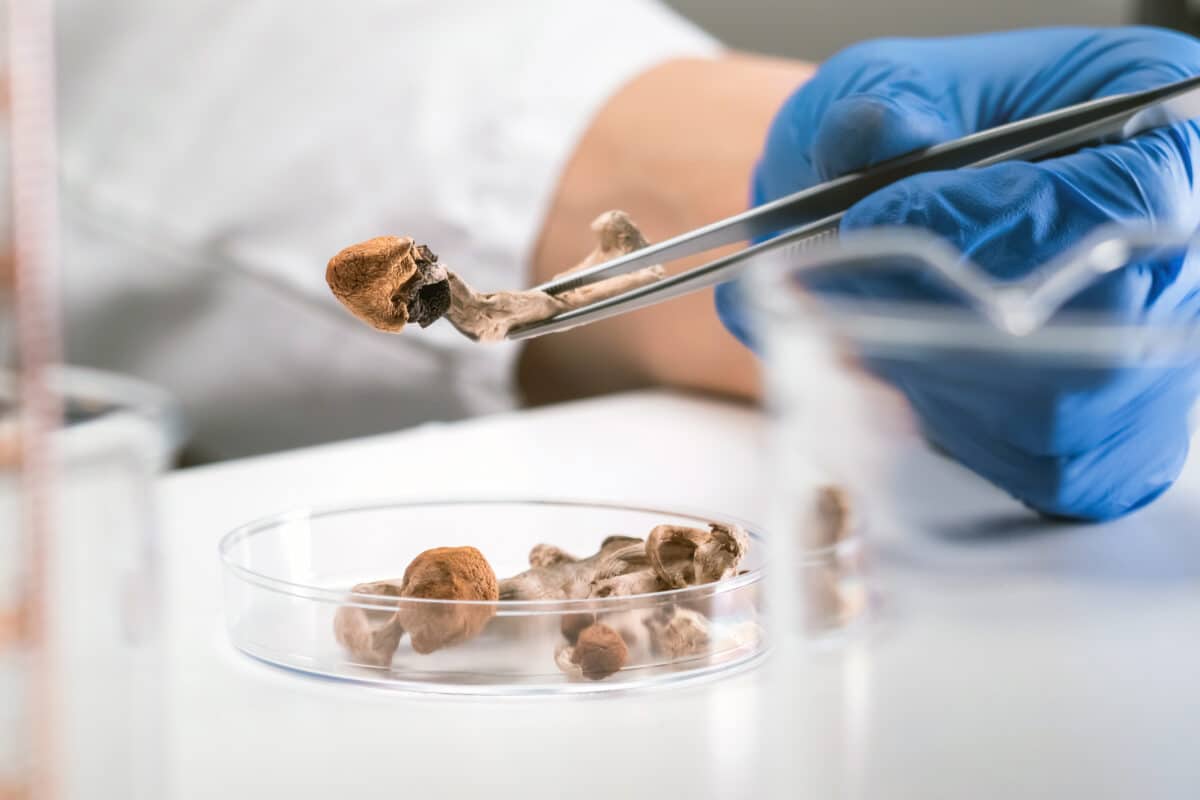Scientists test psilocybin mushrooms in a lab. (Photo by 24K-Production on Shutterstock)
In A Nutshell
One dose, weeks of relief: A single psilocybin injection reversed both chronic pain and depression-like symptoms in mice within 24 hours, with effects lasting at least 12 days.
Brain circuits, not injuries: The pain relief came from calming overactive neurons in a mood-and-pain processing region of the brain, not from healing the actual injuries, which remained visible at the study’s end.
Location matters: Psilocybin worked when it reached the brain’s anterior cingulate cortex but had no effect when injected near the spinal cord, showing pain relief happens in the brain.
Gentle balance beats brute force: Psilocybin’s partial activation of two serotonin receptors simultaneously proved more effective than fully activating either one alone or blocking pain signals entirely.
Pain and depression are intertwined: Mice with worse pain consistently showed worse anxiety and depression, and psilocybin relieved both simultaneously by rebalancing the same brain circuits.
PHILADELPHIA — Researchers at the University of Pennsylvania found that a single treatment with psilocybin, the active compound in magic mushrooms, rapidly reversed both chronic pain and depression-like symptoms in mice. The relief lasted for at least 12 days, the duration of observation after treatment.
The study, published in Nature Neuroscience, confirms what doctors have long observed but struggled to treat: chronic pain doesn’t just hurt the body. It rewires the brain, creating psychological suffering that worsens the original pain.
Chronic Pain Breaks the Brain’s Thermostat
The research team created two types of lasting pain in mice during the four-week study. Some had nerve damage. Others had severe inflammation in their paws. Both groups became hypersensitive to touch and developed what looked like mouse versions of profound anxiety and depression. They avoided open spaces, gave up faster in swimming tests, and showed impaired movement coordination.
Brain imaging revealed the culprit. A region called the anterior cingulate cortex, which processes both the emotional experience of pain and regulates mood, had essentially broken. Think of it like a smoke detector that won’t stop blaring even after the fire’s out. Nerve cells in this area were firing 40% more than they should have been, and they wouldn’t calm down.
Dried psilocybin mushrooms. (Photo by Deep Roots on Shutterstock)
Hitting the Reset Switch
On day 27, researchers gave mice a single injection of psilocybin. Within 24 hours, sensitivity to pain dropped to normal levels in both groups. The mice also returned to typical behavior in tests measuring anxiety and depression.
The improvements lasted. Even 12 days after the single treatment (when the experiment ended), pain relief continued and mood remained stable.
The location of psilocybin’s action mattered enormously. When researchers injected psilocin (what psilocybin becomes in the body) directly into the anterior cingulate cortex, they saw dramatic improvements. When they injected it into the spinal cord near the injury site, nothing changed. The activity levels that had been 40% above normal dropped back to baseline within minutes.
Why It Worked
Psilocybin affects two types of serotonin receptors in the brain: 5-HT2A and 5-HT1A. The researchers found it needs both to work its magic.
When researchers blocked either one before giving psilocybin, all benefits vanished. Pain returned, anxiety stayed high, depression-like behaviors persisted.
But overstimulating those same receptors individually didn’t help either. Maxing out 5-HT2A receptors alone actually increased activity in already overactive circuits. Maxing out 5-HT1A receptors alone decreased activity but provided only modest pain relief and no mood benefits.
Only psilocybin’s partial activation of both receptors simultaneously restored normal brain activity. Rather than blocking pain signals or dampening all brain activity, psilocybin recalibrates specific circuits that chronic pain has knocked out of balance.
Pain and Depression: A Two-Way Street
The study mapped how chronic pain and depression reinforce each other. Mice with either type of chronic pain showed nearly identical patterns: worse pain correlated with more depression and anxiety, measured across multiple behavioral tests.
When researchers examined individual animals, pain severity predicted psychological distress consistently. Both male and female mice showed the same relationship.
In one experiment, mice could choose between two rooms: one where they’d received psilocybin before, and one where they’d gotten saltwater. They spent significantly more time in the psilocybin room. The researchers say this shows the mice associated that space with feeling better, not that they were seeking the drug itself.
The pain relief didn’t come from healing the injury itself. When researchers examined nerve injury sites 40 days later, nerve tangles were still present. The pain reversal came entirely from changes in the brain.
What This Means for People
Of course, while the study used mouse models, keep in mind that human chronic pain involves additional psychological and social complexity. The specific dose, delivery method, and treatment schedule would need extensive testing for human use.
For the 50 million Americans living with chronic pain, along with the large portion who also battle depression and anxiety, the research offers new understanding of how these conditions intertwine in the brain. If similar effects occur in humans, periodic treatment might someday become possible, but that remains unproven.
Early human trials with psilocybin for chronic pain are already underway, though these remain exploratory. Whether the dramatic effects seen in mice will translate to human patients is uncertain, but the neurobiological insights alone advance understanding of how chronic pain transforms the brain and why it resists treatment.
Disclaimer: This article summarizes preclinical research and is for informational purposes only. It does not provide medical advice or endorse psilocybin use outside approved research settings.
Paper Summary
Methodology
Researchers induced chronic pain in adult mice using two established models: spared nerve injury (surgical cutting of two of three sciatic nerve branches) and complete Freund’s adjuvant injection (large-volume inflammatory compound into the footpad). They measured mechanical sensitivity using electronic von Frey testing, which records the precise pressure at which mice withdraw their paws. Anxiety and depression-like behaviors were assessed through elevated plus maze, forced swim test, tail suspension test, open field test, and light/dark box testing. Two-photon calcium imaging in awake, head-fixed mice expressing GCaMP6f allowed real-time visualization of neuronal activity in the anterior cingulate cortex. For drug experiments, researchers used systemic injections of psilocybin (0.5 mg/kg) as well as local applications of psilocin, serotonin receptor agonists, and antagonists. Sample sizes ranged from 5-30 mice per group depending on the experiment.
Results
Both pain models produced mechanical hypersensitivity lasting over 27 days, with withdrawal thresholds dropping to less than 50% of normal. Increased depression and anxiety-like behaviors coincided with the pain. A single dose of psilocybin on day 27 reversed mechanical allodynia within 24 hours, returning sensitivity to pre-injury levels, with effects persisting through day 40. Mood-related behaviors similarly normalized. Two-photon imaging revealed that chronic pain increased spontaneous neuronal activity in the anterior cingulate cortex by approximately 40%, and local psilocin application reduced the hyperactivity back to baseline within minutes. Bilateral psilocin injection to the anterior cingulate cortex replicated systemic psilocybin’s effects on both pain and mood, while spinal injection had no effect. Blocking either 5-HT2A or 5-HT1A receptors before psilocybin completely prevented therapeutic effects. Full agonism at these receptors individually or combined produced only partial benefits compared to psilocybin’s partial agonist activity.
Limitations
The study was conducted exclusively in rodent models, which may not fully capture the complex nature of human chronic pain. All pain models were induced acutely rather than developing naturally. The relatively short follow-up period (40 days) doesn’t address whether benefits would persist long-term or whether repeated dosing might be necessary. Sex-based analysis was preliminary, with some behavioral tests showing small sample sizes for detecting potential sex differences. The mechanism by which psilocybin induces lasting changes beyond its immediate effects remains unclear. The study didn’t examine potential adverse effects or safety concerns beyond basic behavioral observation. Local drug administration experiments required surgical procedures that might themselves influence pain processing.
Funding and Disclosures
This work was supported by the National Institutes of Health (R35GM151160-01) and the ASRA Chronic Pain Medicine Research grant awarded to J.C. Psilocybin was provided by the Usona Institute. The authors declared no competing interests.
Publication Details
Hammo, A., Wisser, S. & Cichon, J. “Single-dose psilocybin rapidly and sustainably relieves allodynia and anxiodepressive-like behaviors in mouse models of chronic pain.” Nature Neuroscience, October 2, 2025. DOI: 10.1038/s41593-025-02068-0



